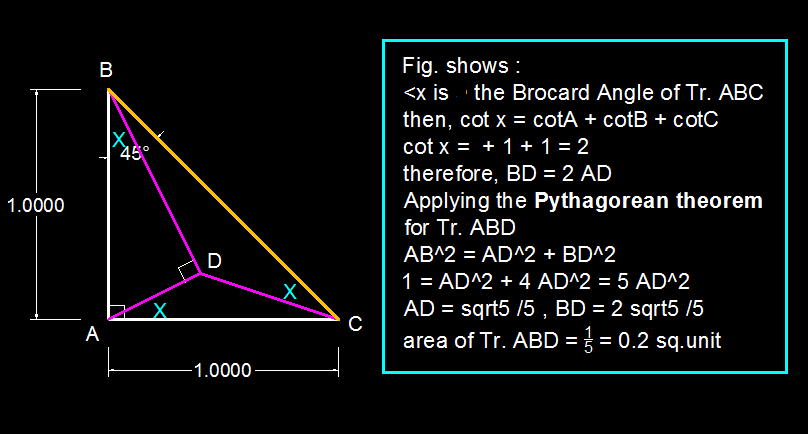Right Isosceles
Given an isosceles right triangle A B C , such that:
A B = A C = 1 , ∠ B A C = 2 π
Let D be a point inside the triangle such that:
∠ A D B = 2 π , ∠ A B D = ∠ B C D
Find the area of △ A B D .
The answer is 0.2.
This section requires Javascript.
You are seeing this because something didn't load right. We suggest you, (a) try
refreshing the page, (b) enabling javascript if it is disabled on your browser and,
finally, (c)
loading the
non-javascript version of this page
. We're sorry about the hassle.
5 solutions

did this question looked like level 4?
This looks amazing! Which software did you use? Does this also support LaTeX?
Log in to reply
Sorry for delaying my reply. The software is AuotoCad for engineers. You can get it from Internet sites or any engineer especially works as a consultant . Note that this software didn't support LaTex.
Visualize triangle B D C of ( 4 5 ∘ − θ ) , 1 3 5 ∘ and θ .
Let B D be a and by Sine rule,
s i n 1 3 5 ∘ 2 = s i n θ a ⇒ s i n θ = 2 a s i n 1 3 5 ∘ = 0 . 5 a
c o s θ = a
T h e r e f o r e , t a n θ = 2 1 ⇒ s i n 2 θ = 1 + t 2 2 t = 0 . 8 , where t = t a n θ
Area of triangle = 2 1 a b s i n θ = 2 1 1 c o s θ s i n θ = 4 1 s i n 2 θ = 0 . 2
A n s w e r : 0 . 2
0.2 + 0.2 + 0.1 = 0.5
The two triangles of 1 3 5 ∘ are of area 0.2 and 0.1 respectively.
Easy. We can consider B as(0,1) ; C as(1,0) ;A as(0,0); D as(h,k). Then applying slope eqns we get k-k^2=h and another eqn 2h=1-k. Now solving we get the point(0.4,0.2). Now from ADB we easily get area=0.2units.
Dead easy problem, just similar triangles, Triangles ADC and BDC are similar. Get relation between BD and DC. Then apply cosine Rule in triangle BDC. Get value of BD(and all other segments). Problem over
Using the sketch by Ahmad Saad, Aplying the Sin law To triangles ADC and BDC, I n Δ A D C , S u m o f i n t e r n a l a n g l e s = 4 5 , ∴ ∠ A D C = 1 3 5 , S i m i l a r l y ∠ B D C = 1 3 5 . S i n 1 3 5 A C ∗ S i n X = D C = S i n 1 3 5 B C ∗ S i n ( 4 5 − X ) . 1 ∗ S i n X ∗ 2 = 2 ∗ ( 2 C o s X − 2 S i n X ) . 1 = C o t X − 1 . ∴ X = A r c t a n 0 . 5 . A r e a Δ A B D = . 5 ∗ . 5 ∗ S i n 2 X = . 2